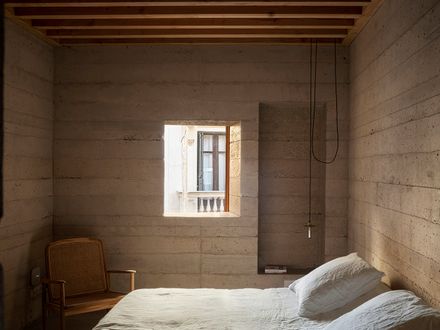TEAM
David Lorente, Josep Ricart, Xavier Ros, Roger Tudó
COLLABORATORS
Miquel Arias, Maya Torres, Maria Ferré, Albert Ferraz
YEAR
2023
LOCATION
Barcelona, Spain
CATEGORY
Houses
Text description provided by architect.
A house in the middle of the city. A house for a family of 5 or 6 members, with quite an amount of program.
A "house" in an area of urban density and on a plot that, despite being quite wide and long, is inevitably surrounded by other buildings and with all the pressure of a big city. Of the existing building, only the street facade will remain, which is a protected facade.
The regulations allow the construction of a ground floor and two floors, with a considerable depth that perfectly meets the needs of the client's program, but at the same time this very deep condition suggests that it could be a house with an interior area that is too dark and bad ventilated.
The project begins with the challenge of qualifying the centre, prioritizing it and turning it into the best place in the house.
It is a wide plot that allows the possibility of recovering traditional typologies of interior patio or atrium, where the centre of the house becomes the best space in the house, the most representative and the one that indirectly qualifies the rest of the spaces that surround it.
Converting the centre into a space much more connected with the outside, full of light and with the possibility of opening up and ventilating the whole house.
A space in between that - although programmed and deeply architectural - lets in the natural intensity of the climate from the roof and divides the house in half, emptying it, making it more spacious and letting it breathe.
A space that, due to its less domestic conditions of height, light and ventilation, manages to convey a feeling of being outside. The verticality of the central space and the zenith opening organize air and light.
They make the invisible visible by sliding natural light to the bottom of the atrium while stimulating the speed of ventilation and the exit of hot air upwards to the exterior.
The program that is organized around the central space is extensive and quite fragmented. We propose a second categorization of the program that hierarchizes it so that each floor has four important spaces that are larger and higher, and these are complemented by secondary spaces that are smaller and clearly of less height.
The hierarchy between rooms is used to absorb the strong irregularity of the plot and solve all the spaces in a regular and orthogonal way in the main pieces. As in an excavated architecture, the different directionality of the spaces is absorbed by the thickness of the walls.
The main pieces always maintain the same position and dimension on all floors, while the complementary pieces vary, adapting and occupying the interstitial and irregular space left between the main pieces.
Large structural walls, very thick and heavy, give the house a lot of thermal stability, but at the same time are selectively hollowed out to accommodate the smallest - and often the most sensitive - programs inside.
The great walls have been built with "poor" cast-in-place concrete. A mixture with very little cement and a selection of sands and gravels which, applied with a compaction technique similar to that of rammed earth, is a very robust and monolithic solution with a lot of thermal inertia but at the same time porous enough to help regulate and stabilize the temperature, humidity and the acoustics of the spaces.
The ceilings of the main spaces are always as high as possible and made of wood in order to differentiate them as much as possible from the complementary spaces, which are entirely mineral spaces excavated within the walls.
The central space is the most collective, the most primordial and special in the house. It is an atrium on the ground floor and first floor combined with a cloister superimposed on the second floor.
Two archetypes with a very forceful geometry and dimensions that fit one on top of the other and from where the distributions are organized.
The atrium is the highest space in the house with four central pillars that free the hole in the central courtyard and that border and frame a virtual space in the middle of the house where the living room will be located.
The upper cloister is a space with similar characteristics, with lots of height and natural light, but without the centrality of the atrium. In the cloister the use, instead of occupying the centre, surrounds the courtyard. It cedes importance to light and ventilation and is located on the perimeter, expanding circulation spaces and sharing with the surrounding rooms. It is an extension of the rooms, the collective space of the rooms.
A house within the city, which due to its typological and constructive characteristics reconnects with traditional Mediterranean characteristic models of the city of Barcelona such as the Gothic courtyards and its bioclimatic and well-being values.
Spaces designed to incorporate and exalt natural light, air stratification or the force of gravity.
A house that tries to recover relationships with what surrounds us; an urban house.































